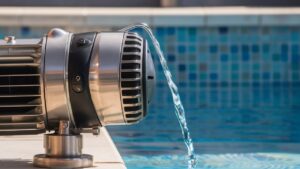Pool suction cleaners are essential tools for maintaining clean swimming pools. They help remove dirt and debris, keeping water clear.
Recommended Best Pool Suction Cleaner 2025
| Recommendation | Product |
| Best Overall | Hayward W3PVS20JST Suction Pool Cleaner |
| Popular Choice | Baracuda G3 Advanced Suction Side Automatic Pool Cleaner |
| Best Value | Polaris MAXX Premium Suction-Side Automatic Pool Cleaner |
| Best Budget | POOL BLASTER Max Cordless Pool Vacuum |
| Another Excellent Pick | Hayward W32025ADC PoolVac XL Suction Pool Cleaner |
Yet, like any equipment, they can face problems that need fixing. Owning a pool suction cleaner can make maintenance easier. But sometimes, these devices encounter issues that hinder performance. Understanding common problems and learning how to solve them is important.
It ensures your pool stays clean and inviting. From blocked hoses to loss of suction, various challenges can arise. Knowing how to troubleshoot these issues saves time and effort. It also prolongs the life of your cleaner. This guide will walk you through typical problems and solutions. Dive in to ensure your pool stays pristine and your cleaner runs smoothly.

Identifying Suction Problems
Pool suction cleaners keep your pool clean and inviting. Sometimes, they don’t work as they should. Suction problems are common. They can lead to poor cleaning performance. Identifying these issues is crucial. It helps maintain your pool’s cleanliness.
Symptoms Of Poor Suction
Your pool cleaner moves slowly. Or it might stop completely. These are signs of poor suction. The cleaner may leave debris behind. Another symptom is if the cleaner gets stuck often. The hose may collapse or flatten. These symptoms indicate a problem.
Common Causes
There are several causes of poor suction. A clogged filter is a frequent cause. It restricts water flow. This affects the cleaner’s performance. Leaks in the hose can also cause issues. They reduce the suction power. Debris in the suction line can block water flow. This results in poor suction as well.
Another cause is a full skimmer basket. It can obstruct water flow. A malfunctioning pump can also lead to suction problems. If the pump is not working well, the cleaner won’t function properly.
Checking The Pump And Filter
Pool suction cleaners are essential for maintaining a clean pool. When they malfunction, the pump and filter often need attention. Ensuring these components work well can solve many issues.
Inspecting The Pump
Begin by turning off the pool pump. Remove the pump cover and check for debris. Leaves, twigs, and dirt can clog the pump. Clear any blockages you find. Examine the pump impeller. It should spin freely. If it doesn’t, it might be jammed. Clean it carefully to restore function.
Cleaning The Filter
A dirty filter can reduce suction power. Locate the pool filter and remove it. Rinse the filter with a garden hose. Remove all debris and dirt. For deeper cleaning, soak the filter in a cleaning solution. Follow the manufacturer’s instructions for this process. Rinse the filter again before reinstalling it. Regular cleaning keeps the filter efficient.
Examining The Cleaner Hose
When your pool suction cleaner is not performing at its best, examining the cleaner hose is a crucial troubleshooting step. A well-functioning hose ensures that your cleaner can move freely and effectively gather debris. Keeping the hose in good shape not only extends the life of your cleaner but also enhances your pool’s cleanliness. Let’s dive into some practical checks you can perform to keep things running smoothly.
Hose Connections
Start by checking the hose connections. Ensure each segment of the hose is securely attached. A loose connection can lead to loss of suction power, making your cleaner inefficient. You might be surprised at how often a simple twist or push of a hose segment can solve the problem.
If your hose is made up of multiple pieces, inspect each junction. Look for signs of wear or damage, such as cracks or splits. Replace any faulty sections to avoid further complications.
Have you ever considered the impact of a small air leak on your pool’s cleaning performance? A tiny gap can drastically reduce suction, affecting the cleaner’s ability to collect debris. Be vigilant about sealing all connections tightly.
Removing Blockages
Blockages are a common culprit for suction issues. The hose can easily get clogged with leaves, twigs, or other debris. Start by disconnecting the hose from the cleaner and the pool skimmer.
Next, run water through the hose to see if anything is obstructing the flow. You can do this by holding one end up to a faucet or using a garden hose. Notice any resistance? This might indicate a blockage that needs to be cleared.
Using a flexible brush or a broom handle, gently push through the hose to dislodge any debris. Always be careful not to damage the hose while doing so. A clear hose is crucial for maintaining optimal suction and keeping your pool sparkling.
Have you ever experienced a sudden drop in your cleaner’s performance after a storm or windy day? Leaves and debris can quickly accumulate, leading to blockages. Regularly check and clear your hose to prevent this from happening.
As you go through these checks, remember that a little maintenance goes a long way. Have any other tips or tricks for keeping your pool cleaner in top shape? Share your experiences and insights in the comments!
Assessing The Cleaner Head
Having a clean and well-maintained pool is a joy, but sometimes your pool suction cleaner may not work as expected. The cleaner head is vital for its efficiency, yet it often gets overlooked. Assessing the cleaner head can make a significant difference in resolving issues. You might be surprised how a simple inspection can get your pool cleaner back to its prime performance.
Checking For Debris
Start by inspecting the cleaner head for debris. Leaves, twigs, and dirt can clog the cleaner, reducing suction power. A quick rinse can often clear the blockage. Have you ever found yourself wondering why your cleaner isn’t moving? It could be a simple matter of debris stuck in the head. Regular checks can prevent this common problem.
Inspecting Moving Parts
Next, examine the moving parts of the cleaner head. Wheels and brushes are crucial for smooth operation. Do they move freely? If not, it might be time to clean or replace them. Think about it: worn-out wheels can hinder movement, leaving areas of your pool untouched. Keep these parts in top condition for effective cleaning.
When was the last time you checked the cleaner head of your pool suction cleaner? Regular assessments can save you time and frustration in the long run. A few minutes can mean the difference between a spotless pool and hours of manual cleaning. Your pool deserves the best—start with the cleaner head.
Reviewing The Skimmer Basket
Skimmer baskets play a key role in pool suction cleaners. They catch debris before it reaches the pool pump. If not maintained, they can cause suction issues. Regular checks can prevent these problems. This guide offers simple steps to ensure your skimmer basket is working well.
Emptying Debris
The skimmer basket collects leaves, bugs, and other debris. These items can block water flow if not removed. Check and empty the basket often, especially in fall or windy seasons. To clean, turn off the pool system first. Then, remove the basket carefully and empty its contents. Rinse it with water to remove any stuck particles. Once clean, place it back securely.
Ensuring Proper Fit
The skimmer basket must fit snugly in its place. A loose basket can cause suction problems. Before reinstalling, inspect the basket for cracks or warping. Such damage can lead to improper fitting. Ensure the basket sits flat in the skimmer housing. It should not wobble or shift. A well-fitted basket ensures optimal suction performance.
Inspecting The Pool Valves
Pool suction cleaners often face issues that need troubleshooting. One key area to inspect is the pool valves. Properly functioning valves ensure the cleaner operates efficiently. Regular inspection can help identify and fix problems early.
Valve Positions
First, check the valve positions. Ensure all valves are in the correct position. Look for obstructions that may block water flow. Incorrect valve positions can reduce suction power. Adjust the valves as needed to restore proper flow.
Testing For Leaks
Next, test for leaks in the valve system. Leaks can significantly impact the suction cleaner’s performance. To check for leaks, listen for hissing sounds. You can also use soapy water to spot bubbles. Bubbles indicate a leak that needs fixing. Tighten any loose connections and replace faulty parts.
Adjusting The Flow Rate
Pool suction cleaners can sometimes have issues, and one common problem involves the flow rate. If the flow rate is too high or too low, it can affect the cleaner’s performance. Adjusting the flow rate properly ensures your pool cleaner operates at its best. This section will guide you on how to adjust the flow rate effectively.
Using Flow Meters
Flow meters are essential tools for measuring the water flow. They help you understand if the flow is too strong or too weak. You can find flow meters at pool supply stores. Attach the flow meter to your cleaner’s hose. It will give you a reading of the current flow rate.
Compare the reading to the recommended flow rate for your cleaner. If the flow rate is off, adjust it accordingly. Most pool cleaners have a dial or valve to control the flow. Turn the dial or valve slowly to reach the desired flow rate. Check the flow meter again to confirm the adjustment.
Balancing Suction
Balancing suction is crucial for optimal performance. Too much suction can damage the cleaner. Too little suction can make it ineffective. To balance suction, start by checking the pool pump’s settings. Ensure it is set to the correct speed for your cleaner.
Next, inspect the cleaner’s hose for any blockages. Blockages can affect suction levels. Remove any debris that might be clogging the hose. After clearing the hose, test the cleaner again. If the suction is still not balanced, consider adjusting the pool pump’s speed again.
Regularly monitor the suction levels. This helps in maintaining the cleaner’s efficiency. Proper suction balance ensures your pool stays clean and the cleaner lasts longer.
Regular Maintenance Tips
Keeping your pool suction cleaner in top condition ensures a sparkling pool. Regular maintenance prevents common issues and prolongs your cleaner’s life. By following some simple steps, you can enjoy a hassle-free swimming season.
Routine Checks
Inspect your pool cleaner for visible damage. Look at hoses, wheels, and brushes for wear. Check the suction power by observing the cleaner’s speed. A slow-moving cleaner might indicate low suction. Clean the filter basket and pump strainer regularly. Debris can block suction and reduce efficiency. Ensure all connections are secure to prevent leaks. Faulty connections can cause loss of suction.
Seasonal Upkeep
Adjust your maintenance routine with the seasons. In spring, thoroughly clean the pool and remove winter debris. Check for algae build-up and clean pool surfaces. In summer, monitor your cleaner frequently. More pool use requires more frequent maintenance. In autumn, remove fallen leaves and other debris. Clean the filter more often to maintain suction. Prepare for winter by storing your cleaner properly. This prevents damage from cold temperatures.
Frequently Asked Questions
Why Is My Suction Side Pool Cleaner Not Moving?
Check for debris blocking the cleaner or hoses. Inspect the filter and pump for clogs. Ensure adequate water flow. Verify hose connections are secure. Adjust the suction settings for optimal performance. Clean or replace worn parts for efficient movement. Regular maintenance ensures effective operation of your pool cleaner.
Why Is My Pool Filter Suction Not Working?
Check for clogs in the skimmer basket or pump. Ensure the pump lid is sealed tightly. Inspect hoses for leaks or blockages. Verify the water level is adequate. Clean the pool filter regularly to maintain optimal suction.
Why Is My Pool Cleaner Not Pulsing?
Your pool cleaner may not pulse due to debris blockages, low water pressure, or a malfunctioning diaphragm. Check and clean the cleaner.
Why Is My Robotic Pool Cleaner Not Picking Up Dirt?
Your robotic pool cleaner might not pick up dirt due to a clogged filter, tangled brushes, or low suction power. Check for blockages, clean the filter, and ensure proper water flow. Regular maintenance ensures optimal performance and dirt removal.
Conclusion
Troubleshooting pool suction cleaners can seem tricky but it’s manageable. Start with the basics. Check hoses for leaks and blockages. Ensure the filter is clean. Adjust the water flow. These steps solve most issues quickly. Regular maintenance prevents future problems.
Keep an eye on cleaner parts. Replace worn-out components promptly. Always consult the manual for specific guidance. Your pool will stay clean with a little care. Enjoy a sparkling pool all season long!








